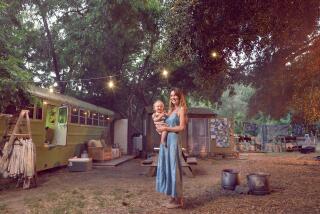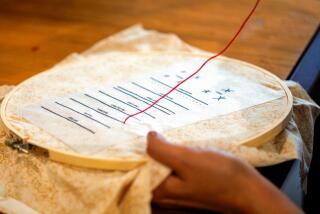Nearly All Clothing Is Fit to Be Dyed
- Share via
Something has happened to tie-dye since the days of peace marches and love-ins. It’s become respectable.
Cruise your local mall and you’ll see tie-dyed rainbows and spirals brightening the clothing racks.
It seems as if every imaginable garment has been dipped into dyes.
There are tie-dyed bikinis in electric Kool-Aid colors at Robinson’s, an elegant tie-dyed jacket and skirt ensemble in green and aqua hues at Nordstrom, ethnic-style pants and matching tops tie-dyed in black with wide rainbow-colored stripes at Charlotte Russe in South Coast Plaza, and even low-priced neon tie-dyed children’s tops and leggings at Target.
Not since the ‘60s has so much tie-dyed clothing been seen in the boutiques of Laguna Beach, which carry casual clothing favored by the area’s artists and beach-goers. “We’re incorporating tie-dye into modern styles, says Lynne Atkinson, the buyer for Ivory Moon, a Laguna clothing boutique. The boutique has tie-dye harem pants and crop tops, oversized T-shirts and leggings and even Polo-style shirts for its more conservative customers.
Seeing tie-dyed clothing hanging from the racks of department stores and boutiques, it’s easy to forget that tie-dye was once outlaw attire--the defiant threads of the ‘60s counterculture. What could be further from corporate pinstripes than those psychedelic colors, swirling and bleeding all over a T-shirt?
This new generation of tie-dye has turned mainstream. Although the most spectacular shirts can still be had in the parking lots of Grateful Dead concerts, it’s no longer just aging hippies who are wearing tie-dye or stirring up batches of T-shirts in their garages.
Nancy Merklinger, an instructor with Piecemakers Country Store in Costa Mesa, remembers tie-dyeing a single T-shirt in the ‘60s.
Although she graduated from high school in 1966--just in time for an 18-year-old to fall headlong into the anti-Establishment movement--she came from an isolated small town and “wasn’t into that hippie business.”
Not until two decades had passed did she again decide to experiment with tie-dye. Now she’s into that hippie business in a big way, tie-dyeing clothing to sell at the Fig Leaf, a clothing shop at Piecemakers, and teaching a tie-dye class to those who want to rediscover this once rebellious folk art, regardless of their age or political persuasion.
“We get people here who look like they never left the ‘60s and we get 70-year-old ladies,” Merklinger says.
“Today tie-dye has a whole different feeling,” she says. “In the ‘60s people thought of tie-dye as the hippies and the youth movement. Now we cater to older ladies. It’s not just for kids any more.”
What brings tie-dye back to Orange County in these conservative times?
Merklinger says brighter colors and crisper lines have again turned people on to tie-dye, thanks to today’s fiber-reactive dyes that produce richer tones than those used in the ‘60s.
“Back then, you tie-dyed with Rit (a household dye) or berries, depending on where you were at,” she says. The dyes bled more, so shirts often had a muddier, washed-out look.
Reactive dyes become part of the fiber instead of coating or hibernating between fiber pores, so they produce clear, vibrant colors.
“The dyes can go from a soft pastel pink to this deep fuchsia,” says Merklinger, showing off a T-shirt she’s wearing that has what looks like white clouds against an almost purple sky. “It’s not all bright and wild.”
Conservative dressers can tie-dye clothes in a single color, with simple stripes running through the fabric. It’s as close to pinstripes as tie-dye ever gets.
People enjoy the sometimes messy craft of tie-dyeing because it allows them to work with their hands, Merklinger says, and they can create something that is unique and entirely their own.
“Each tie-dye is different. You can use the same pattern and the same dyes, but no two will be alike,” she says.
The reasons tie-dyed patterns are as individual as snowflakes is because there is no way to predict exactly how the dyes will penetrate into the fabric.
Individuality is another reason tie-dye is appealing in this homogenous, quality-controlled age.
Merklinger has tie-dyeing down to an inexact science.
In the warehouse where she conducts her classes, she has charts with tiny swatches of fabric to illustrate what different recipes of dyes will look like when treated on cloth.
She teaches four principal methods of tie-dyeing. Students can squeeze colored dyes directly onto the cloth from a squirt bottle, dip the entire garment into a tray of dye, splatter the shirt with a paintbrush or spray the dye on with a spray bottle for a softer, watercolor effect.
Different patterns can be made by folding, pleating or twisting the fabric or tying it with rubber bands, cords, string or tape. The dye won’t bleed through areas where the fabric has been tightly tied or fixed with rubber bands.
Binding the garment tightly with rubber bands will yield stripes. Wrapping it around a piece of twine then scrunching it into gathers will make a cathedral pattern resembling a leaded glass window.
Merklinger can tie-dye anything made from at least 50% cotton: socks, sweat shirts, blouses, skirts, scarfs, hats and tops.
“There isn’t anything you can’t do with tie-dye,” she says.


